Novel Hendra Virus Variant Detected by Sentinel Surveillance of Horses in Australia
- PMID: 35202527
- PMCID: PMC8888208
- DOI: 10.3201/eid2803.211245
Novel Hendra Virus Variant Detected by Sentinel Surveillance of Horses in Australia
Abstract
We identified and isolated a novel Hendra virus (HeV) variant not detected by routine testing from a horse in Queensland, Australia, that died from acute illness with signs consistent with HeV infection. Using whole-genome sequencing and phylogenetic analysis, we determined the variant had ≈83% nt identity with prototypic HeV. In silico and in vitro comparisons of the receptor-binding protein with prototypic HeV support that the human monoclonal antibody m102.4 used for postexposure prophylaxis and current equine vaccine will be effective against this variant. An updated quantitative PCR developed for routine surveillance resulted in subsequent case detection. Genetic sequence consistency with virus detected in grey-headed flying foxes suggests the variant circulates at least among this species. Studies are needed to determine infection kinetics, pathogenicity, reservoir-species associations, viral-host coevolution, and spillover dynamics for this virus. Surveillance and biosecurity practices should be updated to acknowledge HeV spillover risk across all regions frequented by flying foxes.
Keywords: Hendra henipavirus; Hendra virus; One Health; PCR; RNA sequencing; central nervous system; horse diseases; meningitis/encephalitis; sentinel species; sentinel surveillance; syncytia; syndromic surveillance; transdisciplinary research; vasculitis; viral encephalitis; viruses; whole-genome sequencing; zoonoses.
Figures





References
Publication types
MeSH terms
Grants and funding
LinkOut - more resources
Full Text Sources
Research Materials

